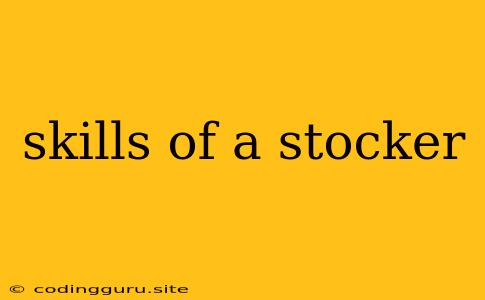What are the Essential Skills of a Stocker?
Working as a stocker is a vital role in any retail environment. It's more than just putting items on shelves; it's about ensuring a smooth shopping experience for customers and maintaining efficient store operations. If you're interested in becoming a stocker or want to learn more about this essential job, let's explore the key skills of a stocker.
Physical Skills:
- Stamina and Physical Endurance: Stocking involves lifting, carrying, and moving merchandise, often for extended periods. A stocker needs to be physically fit and have stamina to handle the demands of the job.
- Manual Dexterity: Accurately placing items on shelves, organizing displays, and handling delicate products requires a high level of manual dexterity.
- Lifting and Carrying Capacity: Stocking frequently involves lifting heavy boxes and merchandise. Understanding weight limits and proper lifting techniques is crucial to prevent injuries.
Organizational Skills:
- Attention to Detail: Stocking involves ensuring that products are properly displayed, facing forward, and organized according to store standards. A keen eye for detail is crucial for accuracy and efficiency.
- Inventory Management: Stocking often includes managing inventory levels, checking for expired products, and rotating stock. Understanding basic inventory principles is helpful.
- Time Management: Meeting deadlines and completing tasks within allocated timeframes is vital. Effective time management skills help stockers maintain a consistent flow of work.
Communication Skills:
- Teamwork: Stocking often involves working as part of a team. Effective communication with colleagues, supervisors, and potentially customers is essential for smooth operations.
- Following Instructions: Stocking involves adhering to specific procedures, guidelines, and instructions. Understanding and following directions is crucial for consistency and accuracy.
Technical Skills:
- Operating Equipment: Stocking may require using forklifts, pallet jacks, or other warehouse equipment. Basic training and proficiency in operating these machines are often required.
- Computer Literacy: Some stocking roles may involve using computer systems to manage inventory, track orders, or access other relevant information.
Additional Skills:
- Problem-Solving: Stocking can present unexpected situations, requiring quick thinking and problem-solving skills.
- Adaptability: Stocking environments can change, and individuals need to be adaptable to new situations and tasks.
- Customer Service: While the primary focus is stocking, a positive and helpful attitude toward customers is always appreciated.
Tips for Improving Stocking Skills:
- Stay Active: Maintain physical fitness to handle the demands of lifting and carrying.
- Practice Lifting Techniques: Learn proper lifting techniques to minimize injury risk.
- Pay Attention to Details: Develop a keen eye for detail to ensure accuracy and efficiency.
- Seek Feedback: Ask for feedback from supervisors or colleagues to identify areas for improvement.
- Take Initiative: Be proactive in identifying and addressing potential problems or issues.
Conclusion:
The skills of a stocker are crucial for maintaining a well-stocked and organized retail environment. From physical abilities to organizational skills, the right combination of attributes enables efficient and effective stocking practices. By focusing on these core skills, individuals can thrive in this essential role and contribute to a positive customer experience.
